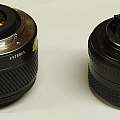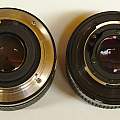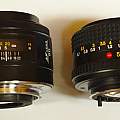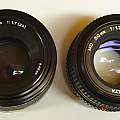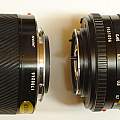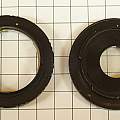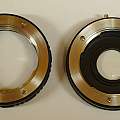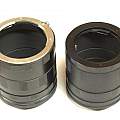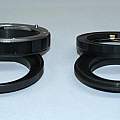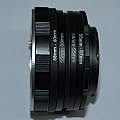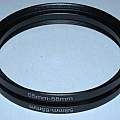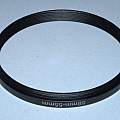MAMD
In 2006 Sony took over the Minolta brand of cameras, renaming it Alpha and retaining the existing Minolta auto-focus lens system, based on the so called A mount used by MA series lenses. Earlier MC and MD lenses use the incompatible SR mount.
It is possible to get adapters that allow the use of MC and MD lenses on MA cameras. This page describes my experience. There are plenty of sources of information about the history of Minolta and the capabilities of the lenses. The little I cover here is stuff I've not seen elsewhere.
I have a Minolta MD 50 mm f1.7 lens. Focus is manual, it has an aperture mechanism, which is not supported by the adapters. Use on the Sony Alpha 200 requires the camera to be in M manual mode. Focusing and aperture can be set by hand on the lens, exposure time has to be manually set on the camera. All this is a lot more difficult than using an MA lens where everything can be automatic.
An MA to MD adapter positions the lens differently relative to the camera sensor, this means it will no longer focus at infinity, the effect is similar to adding a tube extension to use the lens for macro/close-up work. Adapters come in two types "no glass" aka "macro" which can't focus at infinity, and those with a correcting lens which fixes things up so that the full range of focusing works.
Photos of the MD 50 mm f1.7 lens (right), compared with the later AF version (left). Click on small pictures to display large version.
Photos show MA MD adapters, version with built in lens on the right. Grid is 10 mm. Notice the hole in the version with glass in is a lot smaller. First photo is of the end which goes in to the camera, second photo is the end the lens fits in.
The interesting facts are that with the no glass adapter the minimum focus distance is 18 cm from the front of the lens, the maximum focus distance is 27 cm.
For the adapter with a lens the minimum focus distance is 35 cm, and this is the same as for the AF lens.
The no glass adapter is therefore not much use for general photos, if one was expecting a maximum focus distance of a couple of meters then one would be disappointed. But it does make a useful macro lens.
Another way one might consider connecting MA lenses to MD is via sets of macro tubes. These consist of tubes that screw together allowing various lengths to be formed, at one end there is a lens mount, at the other the connector that fits into the camera. The first photo shows the MA version on the left and the MD on the right. Potentially this would let lenses from other mounts be used, since these tube sets are available for other systems. But as the second photo shows, there is a snag. Firstly the tubes have different threads, 60 mm for the MA, and 57 mm for the MD. Although 57 and 60 mm filter threads are not the most common, adapters are easily available. The second and worse problem is that the sets have opposite male/female threading. The MA camera mount has a female thread, the MD a male, and the corresponding difference at the other end.
To connect an MA lens to an MD camera one would need a 60 57 mm male male filter ring connector. The third photo shows that this can be constructed from common parts. From left (MA) to right (MD), a 60 - 58 ring, a 58 - 55 ring which screws into the 58 mm end of a 55 - 58 ring followed by a 55 - 57 ring. The trick here is that the 55 mm thread on a 55 - 58 ring runs all the way through, allowing it to be used as a 55 - 55 male male ring. Photo 4 shows the 58 - 55 and 55 - 58 rings connected together and photo 5 shows the thread on the 55 - 58 ring. Other filter rings that have a 3 mm difference have threads running all the way through and can be used in this way. Female female filter rings are common, they're used for reverse mounting lenses for macro work.
This example (MA lens on MD mount) is the opposite of the commercially available connectors at the start of the page (MD lens on MA mount). However the same conversion as the commercial connectors allow is possible with a lens reversing ring - but would be longer, reducing the maximum focus distance.
David Pilling's Wiki
Set view
